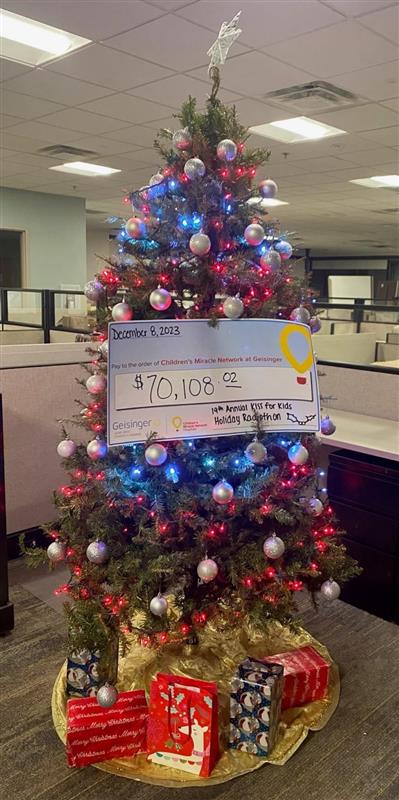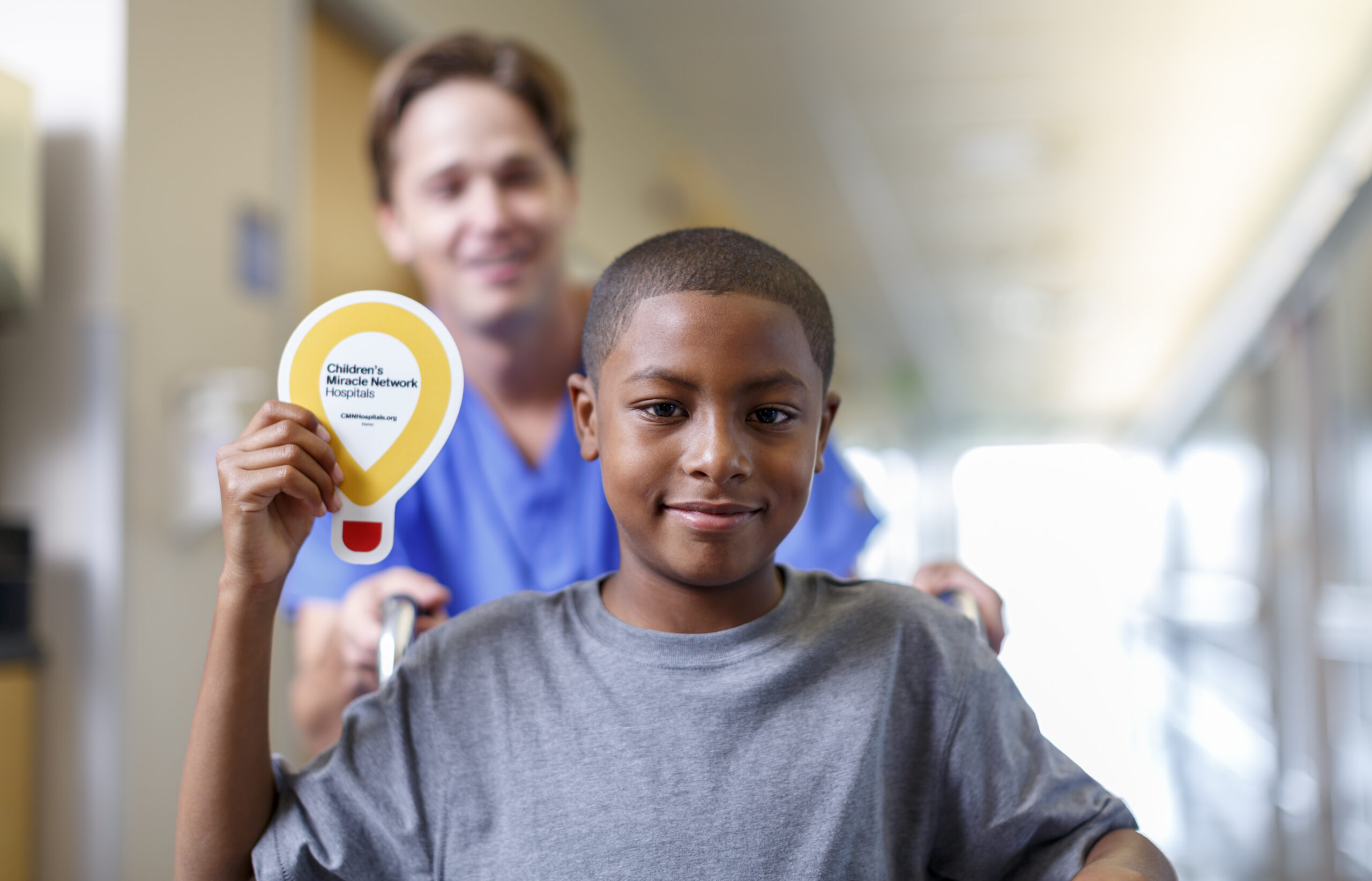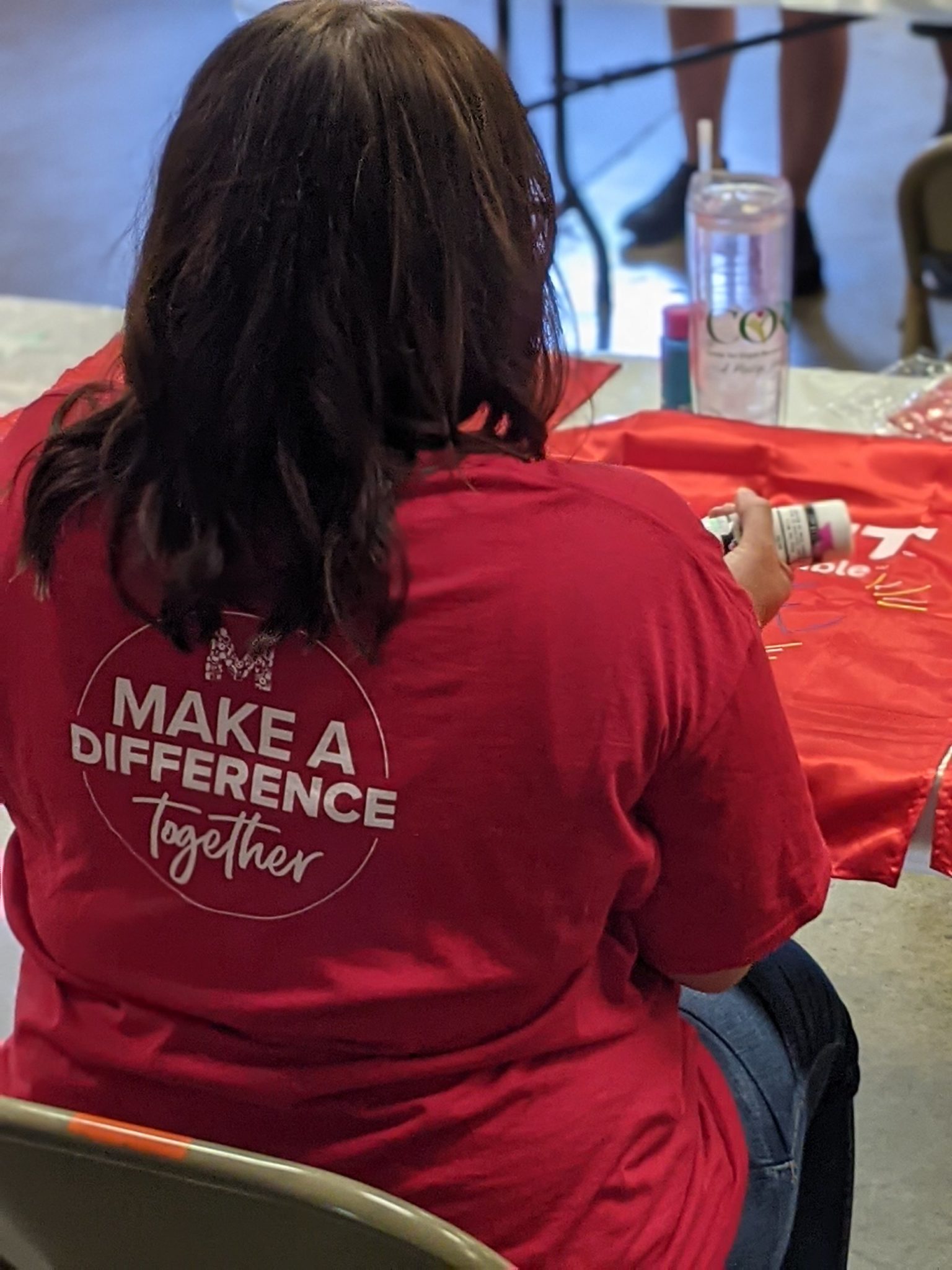2016 Miracle Kid Kimberly Mingle

Nothing stops Kimberly Mingle.
She sprints across the living room, trips over her own foot and lands face first into the semi-soft arm of the couch, a fall that might embarrass or hurt the average 3-year-old and cause a crying fit — but not Kimmie.
“Oops,” her mother Ashley says. Before Ashley can move to check on her, Kimmie bounces up like nothing happened and continues to play.
“She is the toughest girl you will ever meet. That didn’t even faze her,” Ashley says with a chuckle. “I don’t even jump any more, ’cause nothing stops her.”
“She has two older siblings, so she has to be tough,” Kimmie’s father Philip says.
To someone who doesn’t know her, Kimmie’s incredible spirit is even more evident after learning about her fight against life-threatening complications from birth.
Just 17 weeks into the pregnancy, Geisinger doctors discovered the baby had gastroschisis, a birth defect in the abdominal wall where the intestines stick outside of the baby’s body. Gastroschisis happens early in the pregnancy when the muscles in the baby’s abdominal wall do not form correctly. The defect has a high survival rate and can be managed with careful planning. More than 1,800 children are born with gastroschisis each year.
With the diagnosis, Ashley was referred to Geisinger Medical Center’s Center for Prenatal Pediatrics, which allowed caregivers and the family to make preparations for the baby’s birth.
Patients at the center receive care coordination, education and support throughout their pregnancy and after birth. The center is supported Children’s Miracle Network at Geisinger. It allows different specialists from Geisinger Janet Weis Children’s Hospital to plan and coordinate care, reducing the risk of complications.
“Findings such as gastroschisis require critical management in the immediate neonatal period,” said Mindy Lewis, supervisor for the Center for Prenatal Pediatrics. “Ashley participated in a multidisciplinary conference with the center, maternal fetal medicine, neonatology, pediatric surgery, spiritual care and labor and delivery. During this conference specifics regarding the pregnancy were reviewed and plans were made for her and the baby’s care.”
Around 19 or 20 weeks into the pregnancy, Ashley and Philip received more bad news. An ultrasound showed that the baby was missing fingers as a result of amniotic band syndrome (ABS).
While babies are in the womb they are protected by a layer of fluid called the amniotic sac. With amniotic band syndrome, thin strands of tissue form inside the sac and tangle around digits and extremities of the baby like rubber bands. The bands trap body parts affecting the way they form. ABS can amputate digits, arms or legs by tightening around the developing extremities like a tourniquet and not allowing them to develop, according to Lauren Johnson, M.D., neonatologist at Geisinger Janet Weis Children’s Hospital.
“First we found out it was affecting her hands. It was very traumatic to us,” Ashley said. “How do you handle that kind of news? We didn’t know what kind of life she was going to have.”
A few weeks later, Ashley and Philip were told that a band had affected her right ankle, but it was not affecting her foot as dramatically as her hands. Then, at 27 weeks, another ultrasound showed that one of the bands had looped around a piece of her bowel that was outside of her body. Ashley and Philip had to make a decision to either deliver the baby at full-term and risk further bowel damage or give birth sooner and deal with premature issues.
Kimmie was delivered at 29 weeks and 5 days, weighing only 2 pounds, 10 ounces. Doctors began working right away to help her with her congenital issues. Her first surgery was performed immediately by Ronald Scorpio, M.D., director of Pediatric Surgery and Pediatric Trauma. The surgery required placing her intestines back in her belly, creating an ostomy — a small hole in her abdomen where her bowel was brought through. She was connected to a colostomy bag.
“Kimmie had problems with her ostomy and it kept prolapsing (or failing), which required several revisions,” Dr. Scorpio said. “We had to relocate the ostomy because we needed her to get bigger in order to reconnect the two ends of the colon.”
At the same time, the band around her right ankle was causing great concern for the medical staff at the Geisinger Janet Weis Children’s Hospital Neonatal Intensive Care Unit (NICU).
“Her right ankle was completely swollen,” Ashley said. “Dr. Johnson was preparing me for prosthesis. Since she was already premature, I was having a panic attack.”
Doctors were concerned how Kimmie’s ankle would respond if the band was released and worried about the risk of infection, which could result in the loss of her foot. When Kimmie was just over 1 week old, Christian Kauffman, MD, associate in plastic surgery, was asked to help alleviate the banding around her ankle.
“Kimberly was the smallest patient I have operated on,” Dr. Kauffman said. “Because of her size, the nerves, blood vessels, tendons and muscles were all in close proximity and squeezed together even tighter by the constriction band. Releasing the band and closing the tissue was a challenge because she was so small.”
The surgery needed to be completed in three stages to release the band completely, but following the first procedure, the swelling went down and her foot was saved. However, Kimmie continued to fight against her bowel issues.
“She was dependent on intravenous nutrition, she had central lines in and got a central line infection. Her bowel kept not wanting to work so she kept having ileus, which is inability for the bowel to move waste through,” Dr. Johnson said.
After her second surgery on her abdomen, Kimmie hit another stumbling block, acquiring a methicillin-resistant staphylococcus aureus (MRSA) infection. Ashley, Philip and Kimmie were required to spend the rest of their time in the NICU — nearly three months — in isolation because of the infection.
Kimmie needed several more surgeries, some performed by Dr. Kauffman to continue to release the band on her ankle and remove the top of one her fingers which was constricted by a band. The other surgeries were with Dr. Scorpio to reconnect her bowel. However, the reconnection failed and she was once again put on a colostomy bag.
On Aug. 2, following nine surgeries, at least a dozen blood transfusions and 100 days in the NICU, Ashley finally was able to take Kimmie home from the hospital. She needed in-home nursing support because she had developed blood clots in the NICU and needed injections of Lovenox twice a day. Even with the extra care, her stay at home was short lived.
“We knew she was going to come back to the hospital in about two weeks for another hand surgery, but we thought we had her in a good place. She was home for less than two weeks and was readmitted for failure to thrive,” Dr. Johnson said. “She was in for about a week. The first year of her life, more of it was spent in the hospital than out of it.”
Following that stay, Kimmie began to do better — and at 6 months of age, she had a successful second surgery to reconnect her bowel.
But Kimmie’s care at Geisinger was not over. Besides having additional surgeries on her ankle by Dr. Kauffman, Kimmie underwent several surgeries with Joel Klena, M.D., orthopedic surgeon, for her hands. Because of the ABS, Kimmie was left with only five fingers on both of her hands, three on her left hand and two on her right, and she needed more dexterity with her fingers.
“I saw Kimmie when she was around 7 months old. She had syndactyly, which is where the fingers are stuck together,” Dr. Klena said. “The thing that is great about kids is that they are so plastic, even without anything they do so well. At 1 year, she was already using her hands very well.”
Kimmie’s first surgery with Dr. Klena was in August 2013, when she was 16 months old. During the initial surgery, Dr. Klena separated her index and long fingers and took out indentations caused by ABS. To prevent vascular injuries Dr. Klena said he can only operate on one side of the finger at a time.
“You have to stage the procedures, and afterward kids have to wear a club cast so they don’t undo anything that has been done,” he said.
Kimmie would have surgery on one side of her finger, have a cast on for six weeks, then have another finger separated and be in a cast for another six weeks. It’s a long process that is tough on the patients and their families, but not Kimmie.
“Kimberly is one of the only kids who I have performed this surgery on and she can still look me in the eye,” Dr. Klena said with a smile. “She doesn’t want to run away screaming when she sees me.”
For now, Kimmie is done with surgeries and is doing exceptionally well.
“She has no limitations,” Philip said, as Kimmie hops on the couch. “She has all the dexterity in her foot and it doesn’t slow or stop her. When she is around five years old, Dr. Klena may do something to help with the skin on her hands that will keep stretching as she grows.”
Her team of caregivers at Geisinger Janet Weis Children’s Hospital are amazed by Kimmie’s progress.
“When you talk about a child like Kimmie who has been through everything she has and is coming up on 4 years of age, you would expect to meet someone who is tiny and who has been neurologically impacted,” Dr. Johnson said. “She is definitely not impacted. She is a ball of fire.”
“Kimberly is a Miracle Child because she has thrived despite the serious medical problems and multiple surgeries she has had,” Dr. Kauffman said. “She has multiple finger amputations, and she has adapted and overcome this limitation. Her parents have been amazing through the whole process.”
Through the long journey, Ashley couldn’t be happier with the care she received at Geisinger.
“The entire team of doctors that we met along the way, we had met previously through the Center for Prenatal Pediatrics. Everyone came together and said this is what is going to happen,” Ashley said. “Geisinger always never made anything their decision — it was always ours. That was nice.”
The new year will be an exciting one for Kimmie and her family. Kimmie is enrolled at Bloomsburg School of Dance and will start preschool later this year. Also Kimmie is going to be a big sister. The baby is due July 1, Kimmie’s original due date.
“Kimmie says things like, ‘the babies hands aren’t like mine,’” Ashley said. “It makes me upset and gets to me. I explain to her that she is different in some ways.”
Ashley said she has struggled with other kids’ reactions to Kimmie’s differences. Ashley has come home a couple times from the neighborhood play park crying.
“One time a kid said, ‘She’s gross,’” she said. “It upset me that kids could be so mean, but it didn’t bother Kimmie.”
“She pays no attention to it,” Philip said.
Ashley is part of several different groups on Facebook for limb deficiency and limb difference and has taken Kimmie to meet other kids like her.
“She met another girl just like her in New Jersey, when we were there for vacation. She had amniotic band syndrome also on different parts of the hands, but instead of the ankle, it was wrapped around her foot,” Ashley said. “It is nice to meet other parents and kids that understand what we are going through and we understand what they are going through.”
Ashley had such a wonderful experience at Geisinger that she decided to pursue a job with the health system. She also volunteers on the March of Dimes Family Advisory Council for the NICU.
“I started with interim staffing and then eventually applied for a full-time position,” she says. “I am honored to work here since this hospital saved my daughter’s life. I carry the story with me everywhere I go, and tell everyone about the wonderful place I work.”
Ashley and Phil watch as Kimmie smiles and picks Goldfish crackers out of a bowl, while playing with a snow globe.
“She doesn’t let anything stop her,” Ashley said.
Ashley and Philip credit the therapy they got Kimmie involved with early on.
“I think the early start helped her with everything. Getting her the initial therapy she needed was helpful,” she said. “She can do anything she wants.”
“She has definitely come a long way,” Philip says.
“That’s Kimmie, our miracle child,” Ashley says. “Are you a miracle kid?”
“No, not yet,” Kimmie answers.
But Ashley knows that Kimmie is truly a miracle.
“Everything she has been through — she’s here,” she says. “I had never heard of gastroschisis and amniotic band syndrome before she was born. There are so many kids that don’t make it from either of those and she had both. She beat the odds, so she’s a miracle.”
Funding items:
Children’s Miracle Network at Geisinger has funded many items and services involved in Kimmie’s care, including providing financial support for the growth and development of the Center for Prenatal Pediatrics through position funding. Presently funds are being used for a perinatal social worker position, allowing additional patients and families to receive comprehensive care. Funds also provided many items used in Kimmie’s care while in the NICU.






